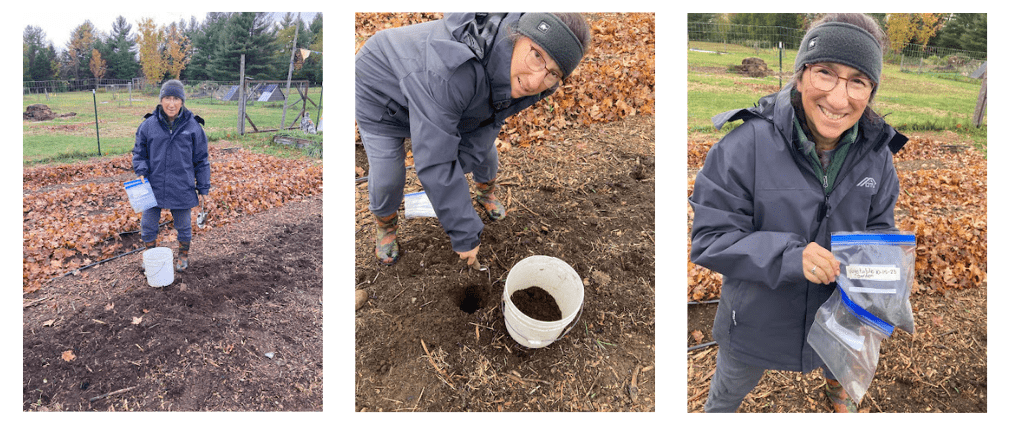On the Growline we get a lot of questions about how to take or submit soil samples, so we’ve put together some frequently asked questions and answers to make it easier. After the why, where, when, what and how of this process, read on to find out who can help you interpret the test results.
Why should I test my soil?
The health of your soil will determine the health of the plants you grow, whether it be a lawn, a field of flowers, vegetables, berries or trees. A thoughtful approach considering the physical, chemical and biological factors that play a role in the total health of your soil will help you get the best results.
So where do you start?
Have a clear idea of what you want to know about your soil and what you want to learn from getting your soil tested. What will you plant? Where is it located? What was planted there before? What are the “neighbors” – plants or trees surrounding the area? Do you know your soil type – sandy, clay, loamy? Each unique area will need to be sampled separately.
- Web Soil Survey use to get description and identify type of soil (sandy, clay, loamy)
When should I test my soil?
Fall is generally considered to be the best time to collect a sample for testing, especially when considering the pH of your soil, however it can be done in the spring or anytime during the growing season.
What do I need?
Gather a few clean tools without rust. Avoid brass or galvanized tools or containers as they will skew your results. A stainless steel probe or soil auger is ideal, but a clean plastic bucket and a rust free trowel or shovel will work for any home gardener. You will also need to double bag your sample in 2 quart-sized sealed zip-lock baggies for each sample area.
How do I take a soil sample?
Walk across and around your garden area in a random, zigzag manner and make about 10 different 4-6 inch deep holes. From each hole, carefully slice a thin vertical section that represents all depths of the soil. Put each slice in your bucket and mix thoroughly. Remove large roots and stones, crush any large lumps or clods, and place about 2 cups of the well mixed soil in a double zip-lock bag. Avoid sampling in wet conditions and in areas where lime or fertilizer has been recently applied.
- Taking a Soil Sample useful illustrations of sampling “zigzag” shown on bottom right
How do I prepare my sample for submission?
Label your bag with your name, date of sample, and type of garden (vegetable). For most home garden submissions, you will need to complete Form H (Home Garden & Lawn) from Dairy One.
- Form H and Crop Codes Soil sample submission form for home lawn, garden and landscape to be completed (Form can be filled in and then printed or downloaded, printed and completed by hand)
Page 3 lists the crop codes used to fill in the form. For example, MVG for Mixed Vegetables.
Which testing package should I choose?
The most commonly used home gardener packages are the preplant (833E) or the maintenance (833M), both test for the following: pH, buffer pH (lime requirement), organic matter, Modified Morgan phosphorus, potassium, calcium, magnesium, aluminum, iron, zinc, and manganese.
If you have a problem area and poor plant growth, however, then you would choose one of the troubleshooting packages (834E) or (834M) which would include a test for excess soluble salts in your garden in addition to the above nutrients

Where do I submit my sample?
Take your sample, completed form and payment to Wight & Patterson, 8 Miner St., Canton, NY (Ph. # 315-386-4171). The Dairy One Laboratory transport system picks up samples on Sunday, Tuesday and Thursday evenings.
When do I get my results?
You will get results in 7 to 14 days by mail, but can usually get it earlier by email.
Can I get help with interpreting my results?
Yes! Contacting the Growline at CCE St Lawrence can put you in contact with a Master Gardener Volunteer who would be happy to go over the analysis with you and answer your questions. They would also help you with any part of the sampling and submission process. Just email SLCgrowline@gmail.com.
Happy growing!
Linda Carney is a Master Gardener Volunteer from Natural Bridge, NY. She is a steward of the Baker Woods Preserve where she facilitates visitors learning about trees, native pollinators, and their role in the environment. She and her husband Matt grow vegetables for their own use and to sell with the least amount of manufactured chemicals and disturbance to the soil.
